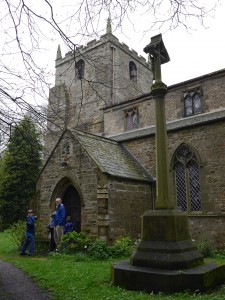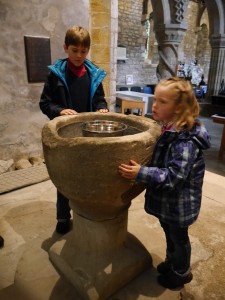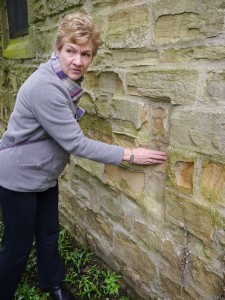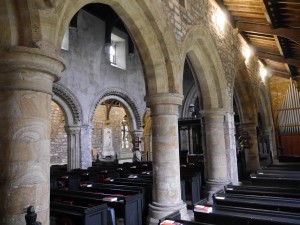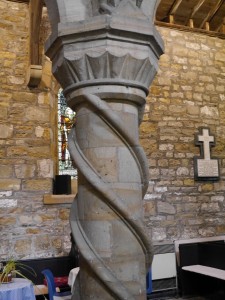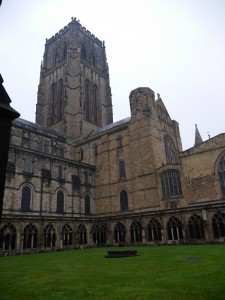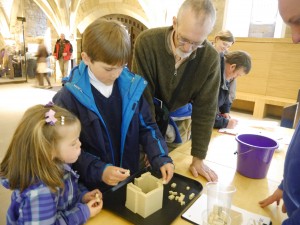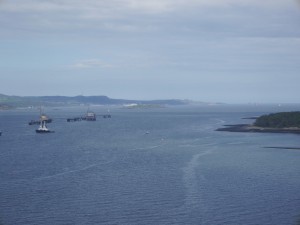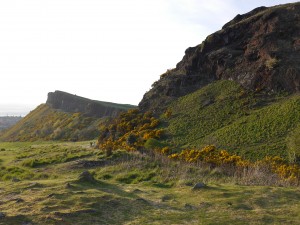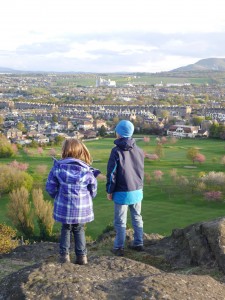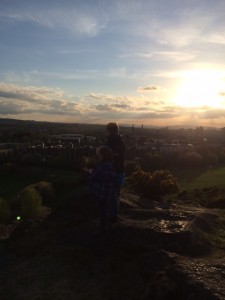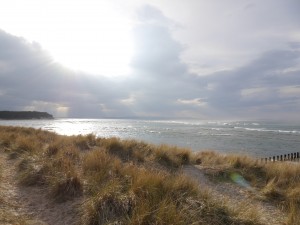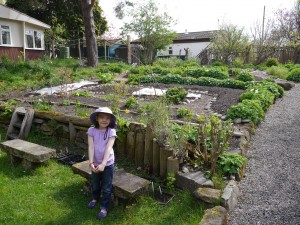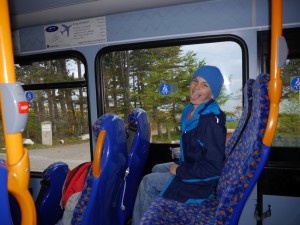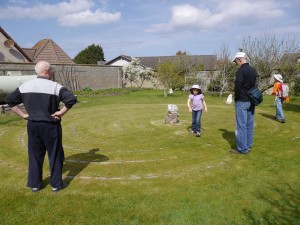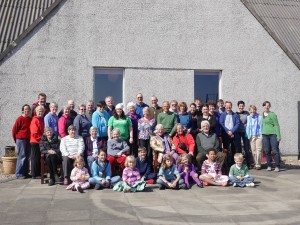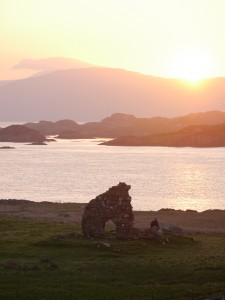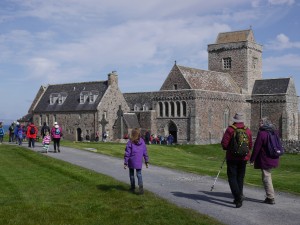With the Gaultney home at Thane as our base, we’ll explore London, experience Shakespeare, walk stone circles, and take in the wonderful variety and rich history which is England.
Monthly Archives: April 2014
Baptized Bovines: From church to field & back again (by Erik)
It was a day of touring the Durham area with our new friend Penny 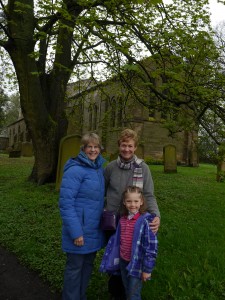 Martin, a good friend of Eldon and Marcia Olson from their Durham days. Penny, a retired Anglican rector, took us to visit a former parish in Pittington, a few miles from Durham. The roots of St. Lawrence Church go back to the fourth century, and portions of the current structure date to the early Norman period (10th century). Many additions and alterations have taken place through the centuries, and it’s a constant struggle to take care of the aging structure.
Martin, a good friend of Eldon and Marcia Olson from their Durham days. Penny, a retired Anglican rector, took us to visit a former parish in Pittington, a few miles from Durham. The roots of St. Lawrence Church go back to the fourth century, and portions of the current structure date to the early Norman period (10th century). Many additions and alterations have taken place through the centuries, and it’s a constant struggle to take care of the aging structure.
The Norman font was of particular interest to me. It was sold in 1805 to a farmer in Belmont and used as a watering trough for cattle for almost 90 years. During that time, the church used a marble font from Durham Cathedral. When the original was rediscovered and reclaimed, the marble font was returned to the Cathedral. If you look closely, you can see how one side of the font has been worn down over the course of many decades from the constant motion of cows stretching their necks to get to the water in the font!
The story of Christianity includes so many examples of words/places/feast days, and other elements, appropriated from some other ancient use and given new purpose and infused with new meaning. Along the winding path, some things, like this font, return to their source purpose, albeit, with a new layer of peculiar history to add to the story! Would that we’d all be as eager to quench our thirst at the Source of baptismal water as those bovine beauties!
Ducklings in Durham (by Naomi)
 Our family is visiting Durham, in the part of England called Northumberland. Today we were going for a morning walk with our friend Penny down by the river Wear. When we walked by an ice cream shop we noticed a momma duck and eleven little baby ducklings! They were really cute! They were small enough that I could hold one in my hand. (But I didn’t.) They had tiny little webbed feet and their bodies were covered with fluffy down with only teeny tiny wings. They were pecking all over the ground, picking up little pieces of ice cream cones left the day before.
Our family is visiting Durham, in the part of England called Northumberland. Today we were going for a morning walk with our friend Penny down by the river Wear. When we walked by an ice cream shop we noticed a momma duck and eleven little baby ducklings! They were really cute! They were small enough that I could hold one in my hand. (But I didn’t.) They had tiny little webbed feet and their bodies were covered with fluffy down with only teeny tiny wings. They were pecking all over the ground, picking up little pieces of ice cream cones left the day before.
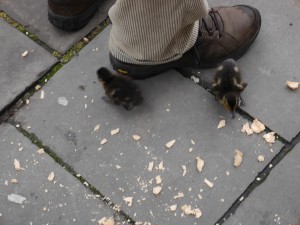 We stopped to watch them. The momma duck started to cross the pathway once, but turned around. Kai and I found some pieces of broken ice cream cones along the path and we picked them up and we scattered them out for the little ducklings. My dad was standing in the path really still, and some of the ducklings started to walk between his legs!
We stopped to watch them. The momma duck started to cross the pathway once, but turned around. Kai and I found some pieces of broken ice cream cones along the path and we picked them up and we scattered them out for the little ducklings. My dad was standing in the path really still, and some of the ducklings started to walk between his legs!
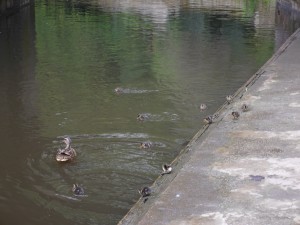 Then, the momma duck saw an opening to cross the path to the river, and so she went across and all eleven ducklings followed behind her. One by one they PLOPPED into the river! A couple of them hopped back out again and then plopped in a second time. And they all began swimming behind their momma. But there was one problem. The current was carrying two of them downstream under the bridge but on the wrong side of the bridge pier from their momma. At first they were swimming slowly against the current. But then, suddenly, they ZOOMED around the corner! They were safely on their way. I wish you could have seen it, because it was SO cute!
Then, the momma duck saw an opening to cross the path to the river, and so she went across and all eleven ducklings followed behind her. One by one they PLOPPED into the river! A couple of them hopped back out again and then plopped in a second time. And they all began swimming behind their momma. But there was one problem. The current was carrying two of them downstream under the bridge but on the wrong side of the bridge pier from their momma. At first they were swimming slowly against the current. But then, suddenly, they ZOOMED around the corner! They were safely on their way. I wish you could have seen it, because it was SO cute!
Durham Cathedral a la Legos (by Kai)
In Durham, we went to worship at the Durham Cathedral with our friend Penny. The cloisters here (that’s the place where monks hung out when it was a monastery many, many years ago) were one of the places where a Harry Potter scene was filmed.
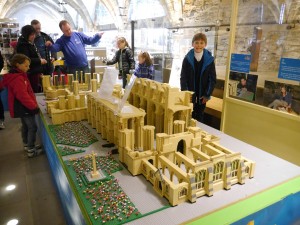 After the service we went to the gift shop area and found out that a huge scale model of the cathedral was being built out of Legos!
After the service we went to the gift shop area and found out that a huge scale model of the cathedral was being built out of Legos!
Dad paid two pounds (British money) and Naomi and I each got to add a Lego brick to one of the towers. When it’s completed, it will contain 350,000 pieces. As of right now there are 68,000 in place.
Edinburgh: Final Salute (by Erik)
During the first half of our time in the British Isles, Edinburgh has been our point of return. It’s the place we first put heads to pillows in the UK, it’s the place to which we returned after our sojourn in Ireland, and it would be our final stop post-Iona and Findhorn before heading south over the Scottish border to Northumberland.
As we approached the city by train after a long journey from the north, our eyes found familiar landmarks and it felt a bit like we were coming home. Our hosts at Aonach Mor, Fiona and Tom, were waiting for us, and so, too, was a warm and gorgeous spring evening. After four hours on the train, we needed to stretch our legs, and Fiona told us that nearby Holyrood Park would be just the thing. Encompassing the remains of an ancient volcano and peppered with evidence of habitation from ancient times, the park was alive with runners, walkers, cyclists, and hikers heading every which way, squeezing every last drop of solar-induced joy from the spring day’s waning light.
Kai wanted in the worst way to climb one of the high bluffs that rose up hundreds of feet at the center of the park, but we hadn’t the time for such an excursion. So we settled for a more accessible hilltop, the site of a fort in days of yore.
From our perch on high we watched the setting sun touch every steeple in the city beneath us, and the feeling of that place was utterly transformed. The gray-stoned, serious city where John Knox had preached his fiery gospel, took on the air of a young lad in love for the first time. What a gift it was to add the memories of that final evening to those we’d already collected at this marvelous city! Farewell, dear Edinburgh!
Strike Three, You’re Out? (by Erik)
Every day of traveling along this sabbatical road brings its own twist of adventure and potential mishap, it seems. Yesterday provided a fistful of them.
 We enjoyed a warm and beautiful spring day on the edge of Moray Firth here at Findhorn yesterday, where northern Scotland meets the North Sea; a day accompanied by blossoming trees and flowers, birdsong, and t-shirt temperatures. The Frisbee came out of the bag, as did the mini-Rugby ball that’s been a favored companion ever since Kai spied it at the Trinity College gift shop in Dublin.
We enjoyed a warm and beautiful spring day on the edge of Moray Firth here at Findhorn yesterday, where northern Scotland meets the North Sea; a day accompanied by blossoming trees and flowers, birdsong, and t-shirt temperatures. The Frisbee came out of the bag, as did the mini-Rugby ball that’s been a favored companion ever since Kai spied it at the Trinity College gift shop in Dublin.
The long, twisting bus trip on HIghland roads from Oban to Findhorn the day before, including Loch Ness (FLASH: NO SIGHTING OF NESSIE) left Naomi and I grasping for motion bags (not the kind of adventure we anticipated!). After transfers at Fort William and Inverness, we had landed at last at the small town of Forres. As we stood at the bus stop contemplating what we would be doing during the hour and a half we must wait before the final five mile leg of our journey to Findhorn, an angel named Gordon, pulled to a stop next to us, rolled down his window and asked us where we were going. “Findhorn,” we replied, and he offered to take us there on his way home. Surprised and delighted at our turn of fortune, we piled in, luggage and all, and in less than 10 minutes we arrived at our destination. A wonderful grace.
Our one full day at Findhorn Foundation’s Ecovillage was a delightful, if brief, sojourn. (Look for another post on our experience touring the village.) Now, with the approach of day’s end, we determined to make a brief foray to the little Village of Findhorn, a mile up the road, and to the rock and sand beaches beyond it that looked north through the Moray Firth toward Norway. We found the local bus schedule was amenable to our goal. Riding it into the old fishing village of Findhorn, it would loop back to pick us up again an hour later on its final run of the day. We paid for a roundtrip fare and hopped aboard for the short trip…Chris and I with our every present shoulder bags and Kai with his backpack with water and his camera.
We found the beach quickly, reveling in the dancing waves and in the light that streamed through clouds, leaving glistening patterns on distant surf. All too soon it was time to head back toward the village to catch the bus. Somewhere along the way, it occurred to me as I looked at Chris with her shoulder bag that I did not have mine. Where was it?! — back on the beach where I’d taken it off when we first reached the water’s edge! I turned and began sprinting back to the shore. That bag not only contained my wallet, credit cards, and all our cash, it also held our BritRail passes and all of our passports! There were a few folk walking the beach with us the few minutes before, might someone have come across it? I dared not contemplate the consequences that would unfold if the bag was gone. Fortunately, I found it just where I’d left it. Strike 1.
Relieved (and a bit winded) I took my time walking back to the family, discovering as I arrived that while my mini-drama was being played out, they had had their own. Naomi had fallen into some gorse (a plant similar in look to Scotch broom but with long, sharp and unforgiving thorns) and as a result had four thorns stuck in her hand. Temporary first-aid applied, we found our bus stop and it was then we discovered that Kai was without his backpack.
Chris quickly pulled out her camera and looked through the pictures to see where Kai last had the backpack on. It was before we had boarded the bus an hour before. He’d left it there, and none of us had noticed when we all got off. New crisis. There was nothing we could do except wait. We knew that the same bus and driver that had picked us up would be returning. And when, a few minutes later, it came around the corner, we sent up silent prayers that, against all odds, the backpack would still be aboard. As he pulled up, we saw it, right in front! He’d found it at the end of his previous run and knew it belonged to us. As we clambered on board for the second time, he said, “I was so hoping you would be here. I was prepared to wait an extra five minutes in the event you weren’t.” Again, relief, and prodigious thanks. “No problem,” he said, “it’s just part of the service.” Prayer answered. Strike 2.
Later the same evening, after the thorns were removed from Naomi’s hand and both kids were fast asleep, Chris and I turned to the internet to catch up on correspondence and confirm future reservations. It was just about midnight that I discovered an email from our B&B hosts Fiona and Tom in Edinburgh asking us to confirm our arrival time, but the date was wrong. Searching through past emails, I discovered that in my original request for an extra night’s lodging an Anoch Mor, I’d gotten the date wrong. How exactly I’d managed that I didn’t know, but there it was. We’d been expected there two nights before and were no-shows. It was too late to phone; all I could do was send an email apologizing for my error and enquiring if the one family room might still—against all odds—be available. Hitting SEND I headed to bed, casting prayers heavenward, both in thanksgiving for resolutions to the day’s crises and in supplication for this latest bungle.
Up quickly this morning, I rang Fiona and Tom. “Aye, Erik, Fiona sent you an email early this morning,” says Tom. “There’s no problem. These things happen. The family room is available and will be waiting for you when you arrive.” Three strikes. No outs. Thanks be to God!
April 24-29
The third leg of our UK pilgrimage takes us by car from Edinburgh to Lindisfarne (Holy Island) and on to Durham. In 635AD, in response to the request of King Oswald of Northumbria that missionaries be sent to bring the Christian gospel to his people, St. Aiden was sent from Iona to establish an Abbey on what would later become known as the Holy Isle of Lindisfarne. We’ll spend one night on the island, timing their arrival and departure to the rhythm of the tides. Then it’s on to Durham, where the bones of another Holy Island saint – Cuthbert – were finally laid to rest after a long and storied journey. [Eldon Olson, retired (but not tired) pastor and member of Peace, spent two years with Marcia and family in Durham completing his doctorate. He’s an excellent source of more of the rich history of this era in Northumberland’s history and the characters that make up the drama.]
Along the way we hope to connect with the Northumbria Community, a contemporary Christian community that’s part of the new monastic movement, whose motherhouse is located between Holy Island and Durham. Finally, we head south via train to the home of our friends the Gaultneys, who live in Thame, outside of London.
April 21-24
Departing Iona on April 21, we travel north past Loch Ness (hopefully stopping there along the way so we can try to spot “Nessie”J) to Moray Bay and the Findhorn Foundation, “a spiritual community, ecovillage and an international center for holistic education, helping to unfold a new human consciousness and create a positive and sustainable future.” We’ll spend a couple nights there, observing how the people of Findhorn combine a zeal for Earthcare with spiritual commitments. Then, it’s back on the train to Edinburgh, where we’ll pick up a car for the next leg of the journey.
Holy Week at Iona: thin place or thin people?
While living and worshipping with other pilgrims at Iona during Holy Week, we were afforded the opportunity of meeting in small groups in order to “go deeper” in our experience. The small group of which I was part included Pat, Fred, Josie, Margaret, Bronwyn and myself. I came to Iona eager to find conversation partners who, like me, were searching for theological approaches to understanding the atonement (i.e. how what took place in Christ’s death and resurrection has made us “at one” with God again) that went beyond the substitutionary/satisfaction theory which has dominated Christian understanding for the past millennium. While that particular conversation has not occurred to the degree I had hoped, many other rich conversations and insights have been part of my experience here. One small group meeting in particular comes to mind.
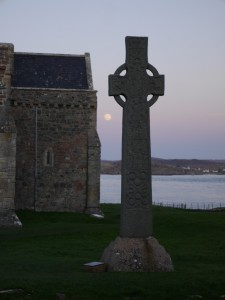
- St. Martin’s High Cross predates the 15th century Abbey by 600 years. It has looked down on an ever-changing world for more than 1,200 years. Sculpted from a single stone, its west face has scenes from the Bible, while its east face is richly adorned with bosses and serpents–symbols of resurrection.
The topic, loosely speaking, was how our faith was manifested in and through our lives. The comments of Fred (a Mennonite from Belgium and frequent visitor to Iona) stuck a sympathetic chord. “We often talk about the importance of our faith having two feet on the ground,” he said, “but this community is one with two boots in the mud.” Two boots in the mud–is not this what every Christian community should seek to be about?
The second comment that evening was from Pat, a former resident member of the Iona Community staff and now disbursed member who contributed in various ways to the week–most notably via hymns she’d written that were featured during the Three Days. “There’s a lot of talk about Iona being a “thin place,” she said (a reference to this island’s long and deep history as a sacred place for nearly 1500 years; a place where, in the words of Iona Community founder George MacLeod, the boundary between heaven and earth is particularly thin). “I don’t know about all that,” Pat said, “but I am drawn to the idea of being a thin person; one in whom Christ’s presence is visible.”
A thin person. Pat’s insight captures the essence of much of what I had been reading and have now been experiencing during this pilgrimage journey. What Patrick, Columba, Brigit, Aiden, Cuthbert, Hild, and so many other Celtic saints share in common–one reason they were revered in their own day and continue to be even now–is that they were all “thin persons,” persons in whose lives and actions one could see Christ manifest. And Pat was bold enough to claim that this “thinness” is not the province of saints alone, but is a way of being in life and world that is open to each of us. This is a welcome counterpoint to the ultra-negative view of human nature which underlies substitutionary approaches to the atonement, and one I am finding terribly refreshing.
In the final worship service prior to our departure from Iona the Monday after Easter , we sang a hymn Pat had written for the occasion of her youngest daughter’s confirmation. Verses 1, 2, and 5 are found below.
Lord of Life and Resurrection, in a graveyard damp with dew, you bequeathed God’s plan and pattern to a weak and frightened few. And the message of their story still today remains the same: Lives surrendered to God’s purpose open up God’s kingdom’s reign. So I set my life before you—all its passion, joy and pain, Contradictions, strength and weakness—to receive your touch again. Breathe your Spirit through its textures, shape its patterns, mend its wrong; so my dying and my living may release your Kingdom’s song. Thus in journey and in action may I make your Presence real; All my loving and my thinking your true patterning reveal. May the life which here I offer make your Kingdom plain to see; Then what started in the graveyard will continue on through me.© Pat Bennett. All rights reserved.
Easter week on Iona
Throughout our time on Iona we have lived in community with people from around the world, including Australia, New Zealand, Holland, Nigeria, Columbia, Northern Ireland, the United Kingdom, and the U.S. Through the week, as we’ve shared meals, faith conversations, music, pilgrimages, worship, and playful moments, strangers have become friends.
The deep history of Iona as a holy place of pilgrimage has left its mark on us. This Easter morning, as we gathered before dawn outside the stone chapel that has witnessed burials for over a thousand years, and walked under high crosses that have marked this ground as Christ’s domain since the 8th century, we heard that joyous proclamation in the voices of the women, “He is not here! He is risen!”
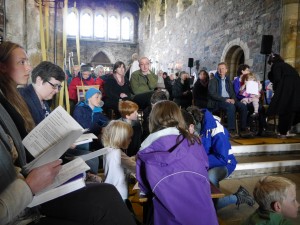 As we continued our festive celebration of the Resurrection in the Abbey Chapel, we lifted a prayer for the celebration other Christian communities around the world–including Seattle–will share as the sun makes its way across the face of the globe. Christ is risen indeed! Alleluia!
As we continued our festive celebration of the Resurrection in the Abbey Chapel, we lifted a prayer for the celebration other Christian communities around the world–including Seattle–will share as the sun makes its way across the face of the globe. Christ is risen indeed! Alleluia!

